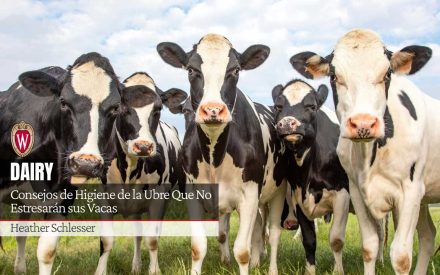A footbath is one of the most important tools used on dairy farms to prevent lameness and maintain hoof health. When used properly and paired with a disinfectant, a footbath can prevent and control foot rot and digital dermatitis on dairy farms. Recently, the recommendations for footbath dimensions have changed after new research was conducted at the UW School of Veterinary Medicine.
This article will focus on the proper installation and use of foot baths on dairy farms and the prevention of lameness in dairy cattle. Specific topics covered on the following pages include:
- New footbath recommendations
- Footbath location
- Retrofitting your current footbath
Updated Footbath Recommendations
Recent research has concluded many of the previous footbath recommendations should be disregarded.
- The updated footbath recommendations feature side walls that are sloped outwardly at a 70° angle to ensure cattle are getting their feet in the treatment bath with each step. Another innovative feature put into the new footbath design is the high walls that are put on the sides. These walls are three feet high and ideally one side would be hinged and able to drop down as a precaution, acknowledging the possibility that a cow may go down while going through the footbath.
- The recommended length of footbaths has increased to 10-12 feet, based on a behavioral trial that was recently conducted. The goal when using a footbath is to have at least two immersions per hoof. The likelihood of this increases from 53 percent in a footbath 6 feet long, to 84 percent in an 8 feet long footbath, and to 96 percent in a 10 feet long footbath. This means, a footbath should be 10 feet long in order to evenly transfer our chemicals onto each hoof as the cattle walk through.
- In the same study, step-in height was also evaluated. A trial was done with a 5-inch step-in height and another with a 10-inch step-in height. The cows responded well to the deeper step, and using a 10-inch step-in height will help retain more of the chemical. With a 10-inch step, baths can be filled with three to four-inch depths and still have enough chemicals left when the last cow passes through, which is not possible with a five-inch step-in height.
- Another dimension that was looked at in this study was the width of the bath. It was determined cows will pass through a footbath with a minimum of 20 inches of width, but it is still recommended footbaths be at least 24 inches wide just to keep the traffic flowing through the bath.
- The UW School of Veterinary Medicine’s Dairyland Initiative Footbath Blueprint recommends a footbath 12 feet long, 24 inches wide, with a step-in height of 10 inches. If this footbath is filled to the most desirable level, which is 3.5 inches, then this bath would hold approximately 52 gallons of solution, which is the same as the traditional footbaths. Side walls should be sloped from a height of three feet above the floor of the bath to the upper edge of the bath, and the sides should be enclosed to create a tunnel.

Footbath Location
The best possible place for footbaths to be located in a free stall or bedded pack/compost barn setup is transfer lanes between the holding area and the pens and in the return lanes on either side of the holding area. If a footbath is located in the return lane, it should typically be about two-thirds of the way down the return alley to prevent cows from causing a jam after exiting the parlor.
In a tie-stall barn setup the footbath should be located where the cows exit the barn or a location where cows must pass through the footbath safely.

 ▶️ Watch: Confort y diseño de instalaciones en granjas lecheras
▶️ Watch: Confort y diseño de instalaciones en granjas lecheras Madigan Squeeze in Calves
Madigan Squeeze in Calves Consejos de Higiene de la Ubre Que No Estresarán sus Vacas
Consejos de Higiene de la Ubre Que No Estresarán sus Vacas ▶️ Watch: Generalidades de la podología bovina especializada
▶️ Watch: Generalidades de la podología bovina especializada


